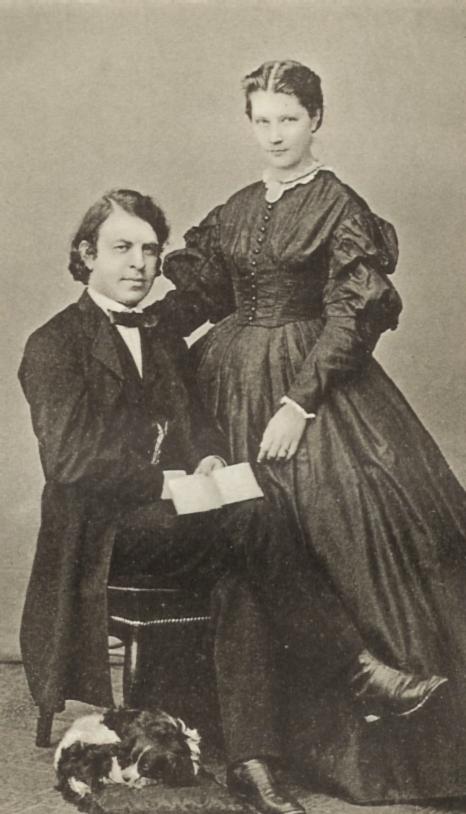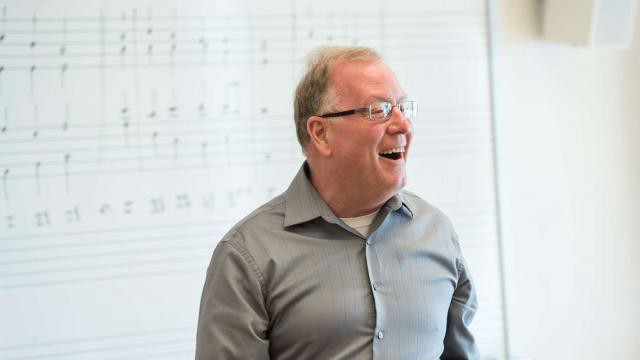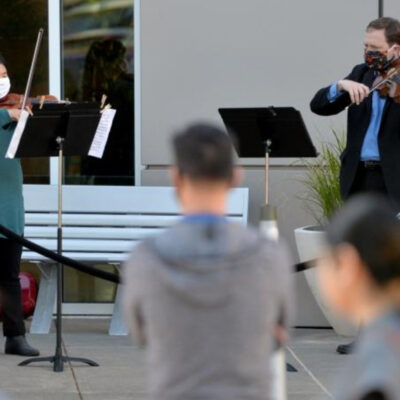
The Joachim Quartet with Joseph Joachim (at the far left) and Robert Hausmann (seated to the right of Joachim), for whom Brahms’ composed his Double Concerto for Violin and Cello.
By California Symphony
Concertos usually offer a single soloist the chance to shine at center stage—to work in partnership with the conductor and orchestra, and put on a show that wows the audience with their virtuosic skills. So why did Brahms deviate from the norm and complicate things by adding a second soloist?
In conceiving his 1887 Double Concerto featuring a cellist and a violinist, Brahms chose to explore a form that had not been given serious consideration in decades. It was the chance to discharge a commitment Brahms had made years earlier to write a piece for cellist Robert Hausmann, but most importantly, it was a way for Brahms to work his way back into favor with longtime friend, collaborator, and muse, Hungarian violinist Joseph Joachim, after the sudden severance of their decades-long, close relationship.
Through the balm of one composition, Brahms hoped to soothe three souls: Joachim’s, Hausmann’s, and his own.”—Music historian Prof Betsy Schwarm for the Library of Congress

Brahms, seated, and Joachim (c. 1855)
Johannes Brahms first met Joachim in Hanover in 1853 at age 20, while he was on his first ever concert tour as an up-and-coming pianist. Just two years older, Joseph Joachim was already famous, his reputation sealed in part after a seminal performance of Beethoven’s Violin Concerto under conductor Felix Mendelsohn—when Joachim was just TWELVE. He was the most renowned and in-demand violinist in Europe, Concertmaster at the Court of Hanover, and a favorite of Franz Liszt.
Joachim became mentor to his less well established friend. Introducing Brahms to Robert and Clara Schumann proved a critical turning point in the young composer’s life as Robert Schumann endorsed Brahms and launched him to the public. Brahms would go on to develop a very close friendship with Clara, especially in later life after Robert’s committal and premature death in an asylum.
For the next thirty years as Brahms’ reputation grew, Joachim took part in premieres of Brahms’ chamber works, and conducted Brahms’ music. Brahms leaned on his friend for help with orchestration, especially when it came to arranging strings. The manuscripts for Brahms’ 1878 Violin Concerto bear the red ink of Joachim’s contributions, and Joachim is credited with coming up with the famous cadenza in its first movement.
Then in 1883, everything changed. Brahms inadvertently got in the middle of a messy divorce between Joachim and his wife, Amalie, as the jealous violinist accused his wife of cheating on him with Brahms’ music publisher—a charge which Brahms did not believe. Brahms’ sympathetic letter to Amalie ended up as evidence during the divorce proceedings, and it helped convince the court to rule in her favor.

Joseph Joachim and Amalie Weiss in happier times.
Part of the letter reads: “With no thought have I ever acknowledged that your husband might be in the right. At this point I perhaps hardly need to say that, even earlier than you did, I became aware of the unfortunate character trait with which Joachim so inexcusably tortures himself and others… The simplest matter is so exaggerated, so complicated, that one scarcely knows where to begin with it and how to bring it to an end.”
Ouch.
Ever the pro, Joachim continued to perform and promote Brahms’ music, however the two did not speak again for four long years.
By 1887, the weight of the silence between the two men weighed heavily on Brahms. And so the composer came up with the idea of a double concerto as a way to resume their collaboration and to patch up their friendship. Joachim recognized the gesture as the olive branch it was, accepted it, and the two reconciled. Brahms conducted the premiere of the Double Concerto the same year, and Joachim (violin) and Hausmann (cello) were the soloists.
At age 54, it was the last concerto Brahms ever wrote, and it was his final composition for orchestra. Ten years later, Brahms would succumb to cancer in Vienna. His great friend would outlive him by another decade.
Brahms’ Double Concerto will be featured on BRAHMS FEST on Saturday, February 1 at 8 PM and Sunday, February 2 at 4 PM at the Lesher Center for the Arts in Walnut Creek. Meet the Artists and read about the friendship between soloists Alina Kobialka and Oliver Herbert. Tickets start at $44 / $20 for students 25 and under with valid Student I.D. and can be purchased online or by calling the Lesher Center Box Office at 925.943.7469.


